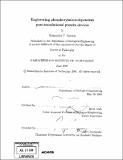| dc.contributor.advisor | Drew Endy. | en_US |
| dc.contributor.author | Sutton, Samantha C. (Samantha Carol) | en_US |
| dc.contributor.other | Massachusetts Institute of Technology. Biological Engineering Division. | en_US |
| dc.date.accessioned | 2009-04-29T17:07:51Z | |
| dc.date.available | 2009-04-29T17:07:51Z | |
| dc.date.copyright | 2008 | en_US |
| dc.date.issued | 2008 | en_US |
| dc.identifier.uri | http://hdl.handle.net/1721.1/45205 | |
| dc.description | Thesis (Ph. D.)--Massachusetts Institute of Technology, Biological Engineering Division, 2008. | en_US |
| dc.description | Includes bibliographical references (p. 117-127). | en_US |
| dc.description.abstract | One goal underlying synthetic biology is to develop standard biological parts that can be reliably assembled into devices encoding higher-order functions. Here, I developed a framework for engineering post-translational devices, which are devices whose inner workings are modulated by non-covalent protein interactions and covalent protein modifications. To test the framework, I designed a scaffold for engineering post-translational devices in yeast, the Phospholocator, that can be used to assemble peptide parts in order to produce devices that couple upstream kinase activity to regulated nuclear translocation. I used the Phospholocator to design, build, and characterize a Phospholocator device, the Cdc28-Phospholocator, whose location is regulated by the activity of cyclin-dependent kinase Cdc28. I next engineered and tested a Fus3-Phospholocator device, whose location is regulated by the activity of the mitogen-activated protein kinase Fus3, in order to demonstrate that the Phospholocator scaffold supports the engineering of many post-translational devices. I used the Cdc28-Phospholocator to follow Cdc28 activity levels throughout the yeast cell cycle, thereby illustrating the utility of the Cdc28-Phospholocator as a tool for biological inquiry. To implement more complex functions, device engineers will want to connect post-translational devices to build multi-component systems. I thus developed a model for device composition that features a universal signal carrier that is both input into and output from post-translational devices. The universal signal could enable engineers to easily combine devices in any desired order, and thus build many new post-translational systems. | en_US |
| dc.description.abstract | (cont.) I next developed a set of specifications and guidelines for designing prototypical protein parts for engineering post-translational devices that communicate via the universal signal carrier. I used the universal signal model and the corresponding set of device specifications to design and model a proof-of-principle. multi-device post-translational system, a post-translational latch, that functions as designed. Taken together, my initial experiences in engineering post-translational devices, defining universal device signals that enable device interconnectivity, and designing, modeling, and analyzing the model of a functional multi-device system, along with the work of many other groups, are sufficiently encouraging to motivate continued work on post-translational devices. | en_US |
| dc.description.statementofresponsibility | by Samantha C. Sutton. | en_US |
| dc.format.extent | 127 p. | en_US |
| dc.language.iso | eng | en_US |
| dc.publisher | Massachusetts Institute of Technology | en_US |
| dc.rights | MIT theses are protected by copyright. They may be viewed, downloaded, or printed from this source but further reproduction or distribution in any format is prohibited without written permission. | en_US |
| dc.rights.uri | http://dspace.mit.edu/handle/1721.1/7582 | en_US |
| dc.subject | Biological Engineering Division. | en_US |
| dc.title | Engineering phosphorylation-dependent post-translational protein devices | en_US |
| dc.type | Thesis | en_US |
| dc.description.degree | Ph.D. | en_US |
| dc.contributor.department | Massachusetts Institute of Technology. Department of Biological Engineering | |
| dc.identifier.oclc | 301815200 | en_US |
